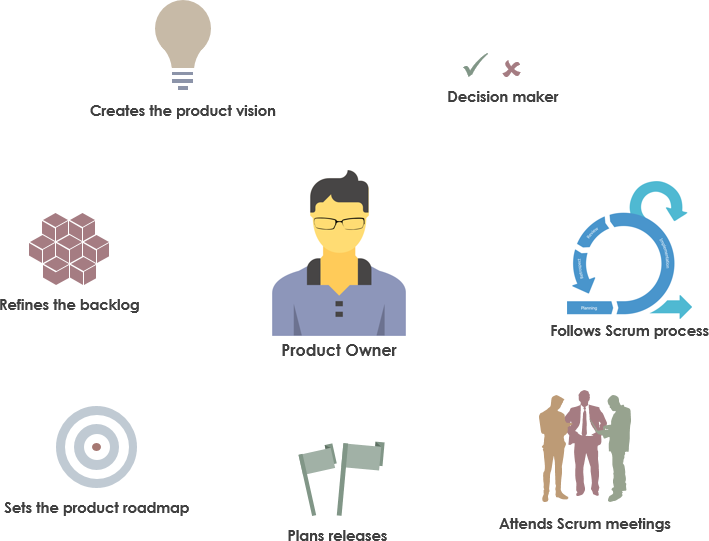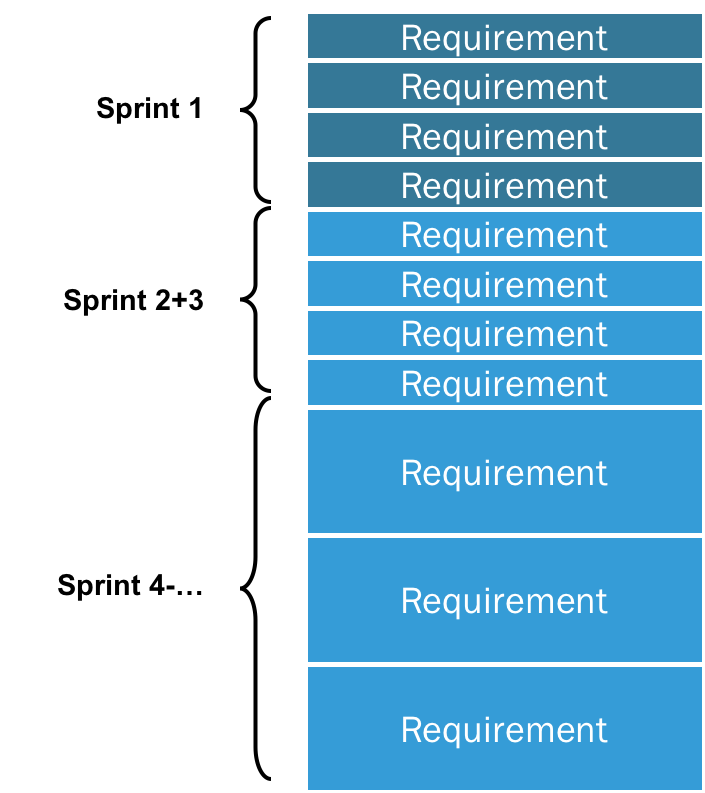Scrum Product Owner: The Role and Responsibilities

A Product Owner is responsible for telling what should be developed and the order of items that needs to be fulfilled. You can consider him as the sole authority that would tell the rest of the team what they need to create and which features should come first. In short, he is the one who tells the other members of the team about what they should be coming up with.
The Product Owner is the sole person responsible for managing the Product Backlog. Product Backlog management includes:
Let’s elaborate the role of a Product Owner in more details as follows:
1. Be the bridge between the business, stakeholders and the team
During product planning, the product owner deals with the stakeholders to get their help in envisioning the product. Whenever a sprint is accomplished, the product owner goes back to the stakeholders and the rest of the team to define what should be done next. When he is planning the sprint with the rest of the team, he provides the input that the development team needs to look at which items in the backlog can be realistically done within the sprint’s time-frame.
2. Work with the stakeholders
As a Product Owner, The product owner is the sole voice of the stakeholder community and he is responsible for stakeholder management. It’s important that you know your stakeholders, their interests. Stakeholders come in many different forms, they may be customers, users, managers, colleagues, etc. etc. and as a Product Owner, you need to manage them and collaborate with them effectively, in order to maximize the value of your Product.
When the product owner is able to work closely with all persons involved in the product creation that are outside the Scrum team, he would be able to gather all the input that he needs to create a coherent vision in the development process. This way, the entire Scrum team prevents unwanted risks in developing features that may not meet client and customer satisfaction.
3. Create and maintain the product backlog
For that reason, he creates the product backlog that contains all the product goals that the development team needs to accomplish when they are ready to start working. The product owner also needs to be available at all times in any case the development team and the Scrum Master has any question about the goals that he has mentioned in his product backlog. Because of this, the product owner bears the responsibility of making sure that the product would be successful during development and maintenance.
As described in the Scrum Guide, a Scrum Product Owner is responsible for maximizing the value of the product resulting from the work of the Development Team. How this is done may vary widely across organizations, Scrum Teams, and individuals.
- Ensuring the Development Team understands items in the Product Backlog to the level needed
- Clearly expressing Product Backlog items.
- Ordering the items in the Product Backlog to best achieve goals and missions.
- Optimizing the value of the work the Development Team performs.
- Ensuring that the Product Backlog is visible, transparent, and clear to all, and shows what the Scrum Team will work on next.
- Ensuring the Development Team understands items in the Product Backlog to the level needed

When the product owner grooms the product backlog, he takes care of the refining, prioritizing, and estimating of the items that are listed there, with the help of the members of the Scrum team. While he may not be entirely knowledgeable of the development process, he is available for consultation and clarification when the development team foresees that some amendments must be made to meet their deadlines.
This ensures that goals are updated according to the work that can be done during production and that backlog items can smoothly flow into the next sprints.
4. Ensure the “Definition of Done”
Make criteria on what is acceptable and check that people are meeting them The product owner makes sure that all goals that should be met in a sprint session have been accomplished by seeing to it that both non-functional and functional requirements have been met by the team. He may consult with experts to do this or get assistance from the development team.
The acceptance criteria are crucial to the Scrum team because it tells everyone about the project’s progress. Without them, the development team would not be able to understand what defines a completed work and would not be able to include better practices on their next sprint.
5. Work with the development team
The job of the product owner becomes an everyday role since he is required to stay engaged in the tasks of the development team in order to prevent delays on essential feedback that can already be incorporated within the day. Here is the tips on how the Product Owner to collaborate with the development team suggested by Roman Pichler:
- Manage the Product, not the Team
- Treat the Team as an Equal Partner
- Help the Team See the Bigger Picture
- Involve the Team in Product Decisions
- Spend Enough Time with the Team but Don’t Neglect your Other Duties
- Expect High Standards but Don’t Pressurise People
- Give the Team Time to Experiment and Learn
- Fully Participate in the Meetings
Scrum Roles Articles
- What is Scrum Team?
- What is a Self-Organizing Team in Scrum?
- How Scrum Team Works? — A Brief Guide
- How to be a Good Product Owner in Scrum Project?
- What is Product Owner’s Role in Scrum?
- Agile Development: How to Become a Qualified Scrum Master?
- What is Pig and Chicken in Scrum?
- Project Manager vs Scrum Master vs Project Owner
- What Are The Three Scrum Roles?
- What is a Scrum Master? The Role and Responsibilities
- What is Cross-Functional Team in Agile?
- As a Scrum Master, How Can You help Your Project Owner?
This post is also available in Deutsch, Español, فارسی, Français, Bahasa Indonesia, 日本語, Polski, Portuguese, Ру́сский, Việt Nam, 简体中文 and 繁體中文.













